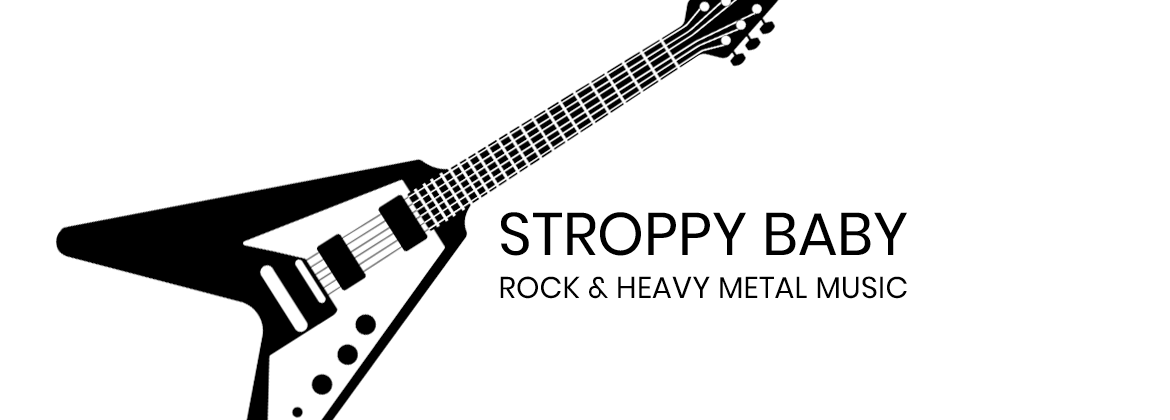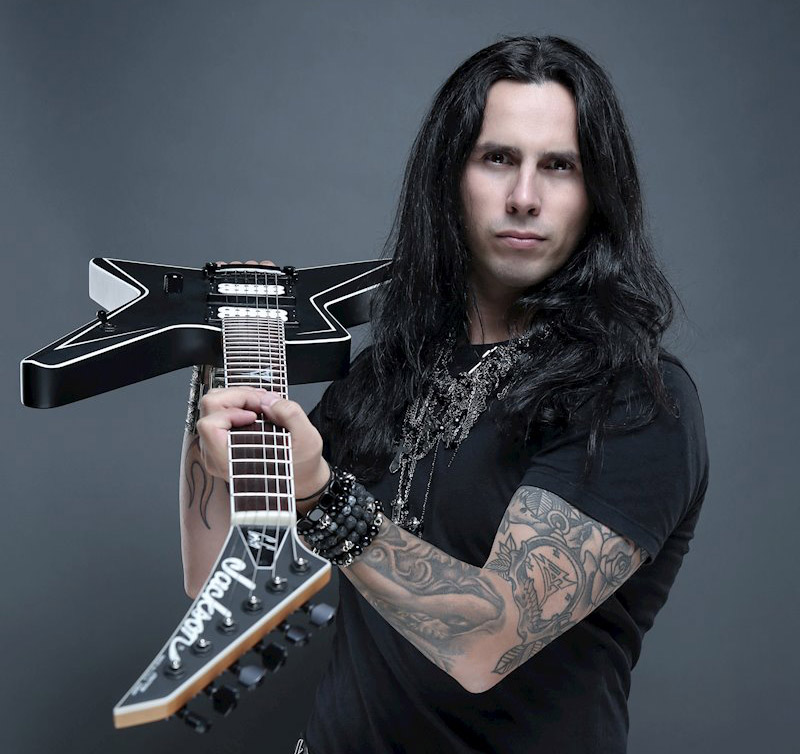Recently touring Australia for the first time with his own band Firewind, current Ozzy Osbourne guitarist Gus G spoke to Australian Guitar (Paul Southwell) via phone about all things guitar. Highly acclaimed worldwide with an array of signature musical equipment gear and with a hard earned virtuoso playing skill, those who saw him live in Australia witnessed a seasoned professional guitar wizard.
AG: What amplifiers work for you when touring?
GG: Blackstar amps are really good for touring gear around the world. When we tour on a bus with Firewind I carry my own gear. Since these are fly in and out gigs, they are supplying my backline in every city. For an arena tour with Ozzy, we carry that stuff in trucks and ship it around the world.
AG: What are some of your previous amplifiers and pedals used over the years?
GG: A couple of signature 200 watt Randall amps are in storage but the last time I used them was in 2009. Earlier on, I used Engl amps and the EVH 5150s then I moved on with Randall. Then a few years ago, Blackstar sent me an amp in the studio when I was doing the ‘Scream’ album with Ozzy. From there, we created my own amp, the Black Flag 200. We modified the distortion circuit but the valves stayed the same. I used the big ass tubes, the KD88s and they produce a really big sound. The BBE Green Screamer is like a booster for my leads to tighten up the distortion for the leads and give a little bit of extra sustain. I developed a signature pedal out of the Green Screamer called the G Screamer.
AG: Plus you’re using active pickups and Seymour Duncans? Is that a lot of gain?
GG: It is, my pickups are active and really hot pickups. I don’t put that much gain on my amp, it is more to get the voicing or tone rather than turning up the gain to ten. My gain is only half way up there and the same thing with my pedal as well, the gain is always up to twelve o’clock to give that extra bite. You don’t want too much gain where it feeds back.
The secret to make the sound clear and crispy is to not have too much gain. I like that high gain distortion or colour of the sound to have that big, warm, fat distortion but it doesn’t mean that it turn it all the way up because that is when things get muddy. I roll down the volume a lot when I have to play cleaner melodies. A very Schenker style.
AG: How big an influence was Jake E. Lee, Zakk Wylde and Randy Rhoads on you?
GG: I grew up with those records. I was big on Jake E Lee when I picked up the guitar at around fifteen years old. I really liked ‘The Ultimate Sin’. I remember watching the first Ozzy video on TV. They broadcast the show they did in Moscow and that was when I first saw a young Zakk Wylde. I was blown away so then I checked out ‘Diary of a Madman’ and started practicing Randy Rhoads songs. I definitely sank my teeth into those songs. I am probably a bigger Tony Iommi fan of them all. I’m a huge Sabbath fan.
AG: Did you ever get into Racer X and ‘Speed Metal Symphony’ by Cacophony?
GG: Totally man, are you f**king kidding me? Those bands are The Bible for shred. I listened to all that stuff before I studied with Joe Stump at Berklee. I played ‘Second Heat’ [Racer X] on vinyl day and night. Early Yngwie Malmsteen records are what started it for me as he was one of my biggest influences.
AG: Given you were born in 1980, do you feel like you missed the shred era?
GG: I started playing when I was nine or ten so I didn’t know about that stuff. I got into heavy metal and shred guitar in the mid nineties. When I got into that, grunge was big. I was into Nirvana, Pearl Jam and what was on MTV at the time but I also dug shred and heavier speed metal. When I was learning guitar I would learn everything I could. Practice would go from learning Nirvana to Yngwie’s ‘Trilogy’ and going from there to listening to SRV or Jeff Healey. My brain was like a f**king sponge. More of the southern European countries have an audience melodic rock and power metal.
AG: Aside from the obvious, how do production aspects vary from Firewind to Ozzy?
GG: For Firewind, I’m involved with everything and have the last say in this band. I work together with the other guys but ultimately I will make the suggestions on studios, producers and mixers to use. I’m actively involved in the creation of an album whereas with Ozzy, when I joined on the ‘Scream’ album, everything was written and done. They just needed someone to play guitars. I got hired to play guitar and given the situation I did pretty well because it was a tough task to play on an album for which I didn’t write anything. All of a sudden they didn’t have any solos and they were like, ‘well you make guitar noises on these fifteen songs’ and I didn’t know what they wanted and nobody told me anything. So I just did my best and I’m proud of what came out. There are some really strong tracks on that album as well.
AG: Was it almost like being a session musician?
GG: I tried to approach it that way but not too much because I knew that this had to be something that I loved. There were going to be tonnes more people who didn’t know who the f**k I was and the first thing they would ever hear me play on was the first Ozzy single. It had to be something that identified me as a player. So, I didn’t approach it as another session. I tried to make it my own by putting a bit of my own style into it when I played the leads and riffs. I’m proud of it and I’m proud of being part of an Ozzy record. Not many guitar players can say that. There is only one Ozzy. No one can replicate him.
AG: Which of your signature ESP guitars are you most proud of at this point?
GG: All of them, they are all of my kids. For developing them, I will go to ESP with ideas on what to do and they will get back to me. I create all of my guitars at the Japanese custom shop and I usually take from six months to a year to get a guitar done. I’ll give them the specs, they’ll make the first prototype and they’ll send that to me and then I’ll go back to them and tell them what we need to change or not then we’ll make the final version. Then, if happy, we’ll put it out on the market. I grew up with a Strat so I like my guitars to have that feel. I like the rosewood neck and alder body. I use those woods on my Random Stars [ESP LTD] but on the Eclipse [ESP Gus G Eclipse] model that I did which is more like a Les Paul shape. I used a different wood on the body; mahogany or ash. Those guitars get a slightly heavier or darker sound for doing the Sabbath songs.
AG: For Firewind’s recent live albums, were there any difficulties?
GG: In 2008, that one was one show that we recorded and we had to play ‘The Premonition’ from start to finish. So we had to play everything from the new album. The difference with this new live album is like a retrospective of our career. It was not one show recorded but actually twenty five shows recorded over Europe and Greece. In the end we picked out the best performances and that is how we put it together. We were recording a bunch of shows and after a while we stopped thinking about it.
AG: Which of the Firewind albums represents everything coming together?
GG: I think the most cohesive album and one that flows best from start to finish of all the albums we’ve done is probably ‘The Premonition’. It doesn’t have to do with musicianship necessarily, not that we didn’t play well. I’m not judging this by the hardest stuff since we’ve played more technical stuff since then. Firewind started out backwards. It was just me and studio musicians with the first three albums searching out for out musical identity. The fourth album ‘Allegiance’ was when the steady line up came together and you could see that album was the breakthrough album for us. We tried to establish our own sound. ‘The Premonition’ was that album where we finally found our sound and style and that was kind of the defining moment for Firewind.

